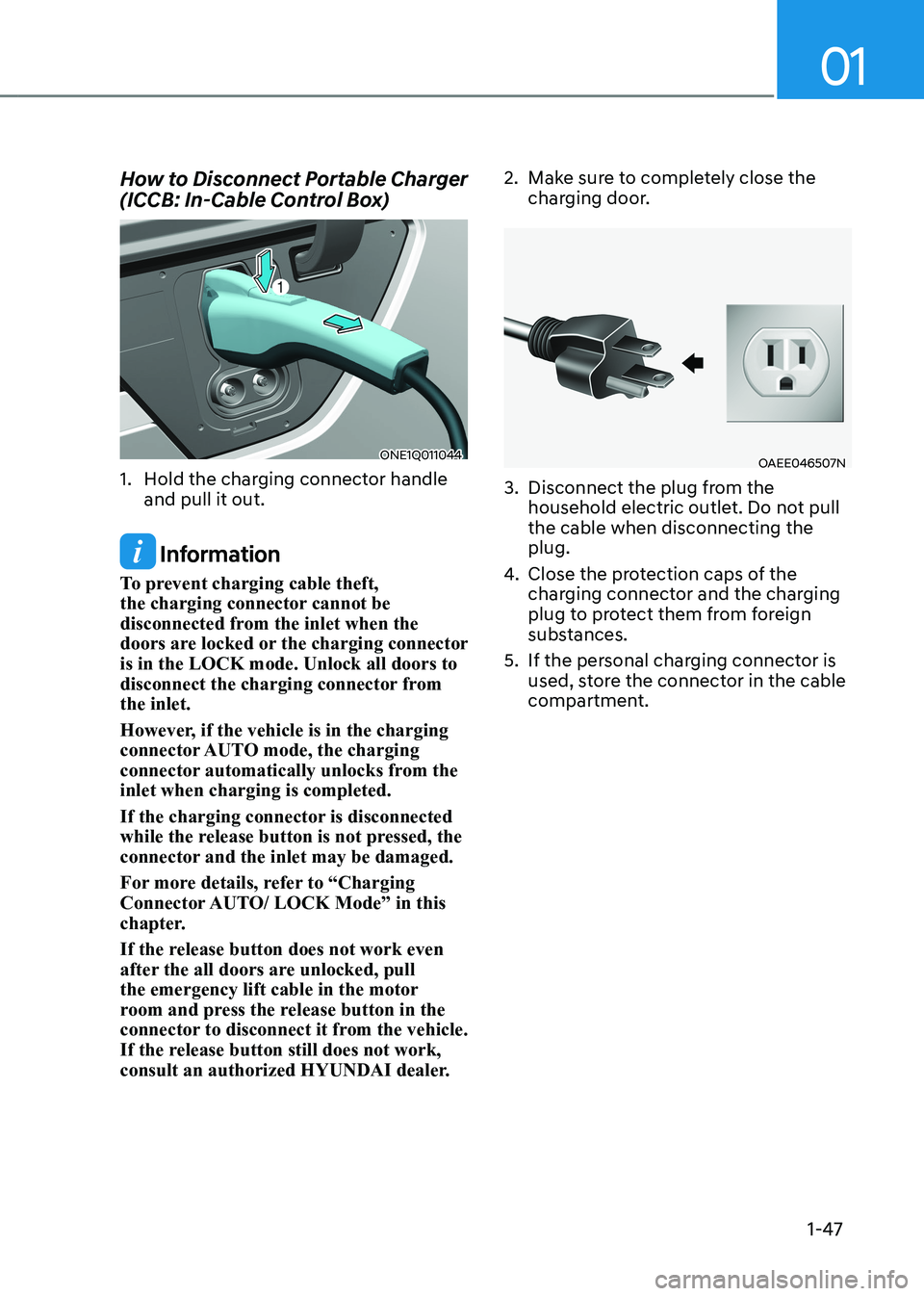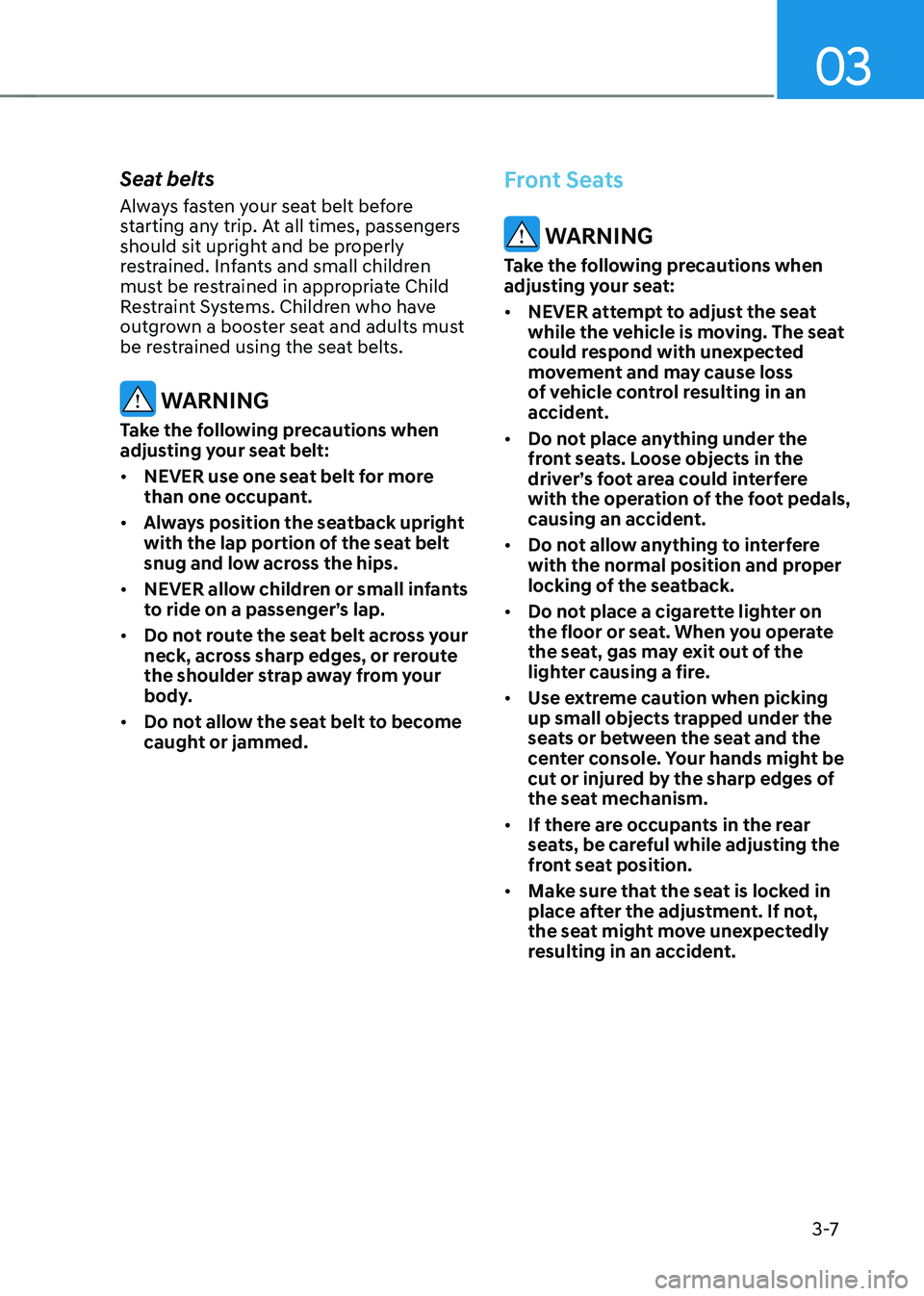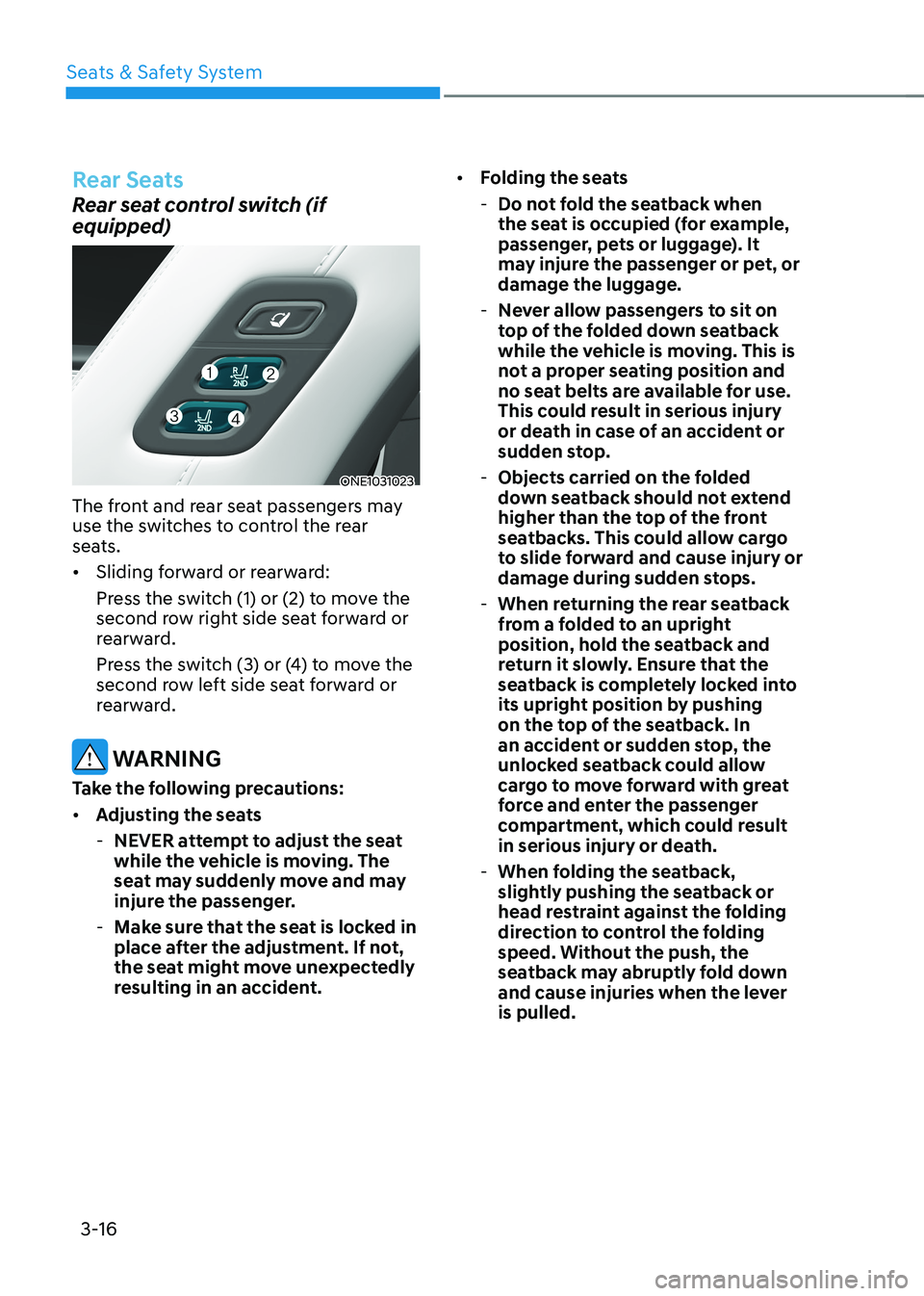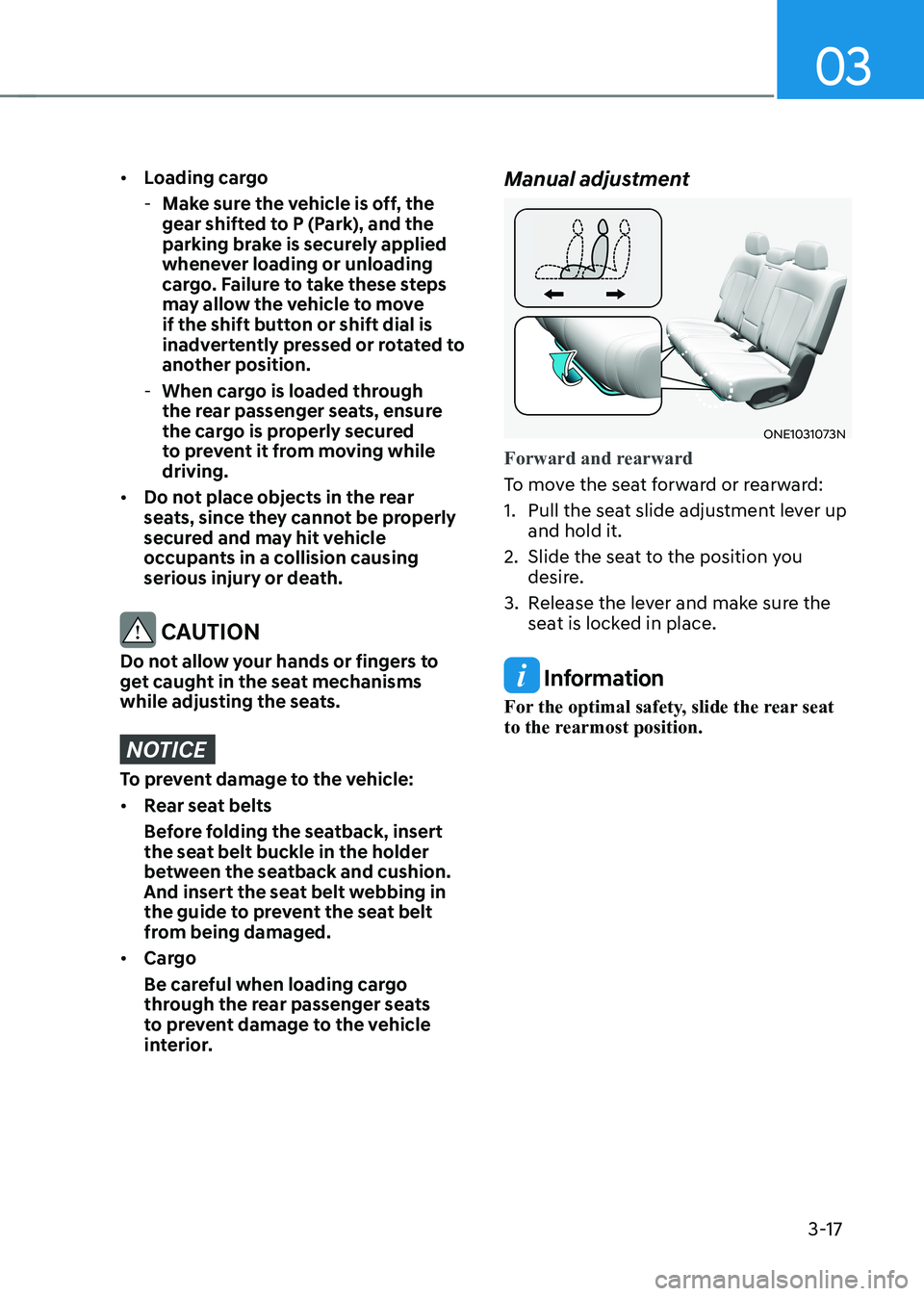2023 HYUNDAI IONIQ 5 lock
[x] Cancel search: lockPage 52 of 680

01
1-47
How to Disconnect Portable Charger
(ICCB: In-Cable Control Box)
ONE1Q011044
1. Hold the charging connector handle and pull it out.
Information
To prevent charging cable theft,
the charging connector cannot be
disconnected from the inlet when the
doors are locked or the charging connector is in the LOCK mode. Unlock all doors to
disconnect the charging connector from the inlet.
However, if the vehicle is in the charging
connector AUTO mode, the charging
connector automatically unlocks from the inlet when charging is completed.
If the charging connector is disconnected
while the release button is not pressed, the
connector and the inlet may be damaged.
For more details, refer to “Charging
Connector AUTO/ LOCK Mode” in this
chapter.
If the release button does not work even
after the all doors are unlocked, pull
the emergency lift cable in the motor
room and press the release button in the
connector to disconnect it from the vehicle.
If the release button still does not work,
consult an authorized HYUNDAI dealer. 2. Make sure to completely close the
charging door.
OAEE046507N
3. Disconnect the plug from the household electric outlet. Do not pull the cable when disconnecting the plug.
4. Close the protection caps of the
charging connector and the charging
plug to protect them from foreign
substances.
5. If the personal charging connector is used, store the connector in the cable
compartment.
Page 74 of 680

2-4
Vehicle Information, Consumer Information and Reporting Safety Defects
The actual shape may differ from the illustration.
ONE1011003N
1. Inside door handle ................................5-34
2. Integrated memory system .................5-40
3. Side view mirror control switch ...........5-60
4. Side view mirror folding button........... 5-60
5. Central door lock switch ......................5-34
6. Power window switches ......................5-63
7. Power window lock button / ...............5-65
Electronic child safety lock button .......5-37
8. Instrument panel illumination ...............4-59.
ESC (Electronic Stability Control) OFF
button .................................................... 6-37
10. Power liftgate open/close button ........5-78
11. AUTO Hold button ................................6-32
12. EPB (Electronic Parking Brake) switch ..................................................... 6-27
13. Hood release lever .................................5-73
14. Steering wheel tilt/telescopic lever ....5-45
15. Steering wheel ...................................... 5-44
16. Seat .......................................................... 3-3
17. Cluster fascia side panel .....................5-130
InterIor overvIew
Page 93 of 680

Seats & Safety System
3-6
Information
The information provided may differ
depending on which functions are
applicable to your vehicle.
Safety Precautions
Adjusting the seats so that you are sitting
in a safe and comfortable position plays
an important role for the safety of the
driver and passengers, as much as seat
belts and air bags when in an accident.
WARNING
Do not use a cushion that reduces
friction between the seat and the
passenger. The passenger’s hips may
slide under the lap portion of the seat
belt during an accident or a sudden
stop.
Serious or fatal internal injuries could
result because the seat belt cannot
operate properly. Air bags
You can take steps to reduce the risk
of being injured by an inflating air bag.
Sitting too close to an air bag greatly
increases the risk of injury in the event
the air bag inflates. Move your seat as
far back as possible from front air bags,
while still maintaining control of the
vehicle.
WARNING
To reduce the risk of serious injury or
death from an inflating air bag, take the
following precautions: • Adjust the driver’s seat as far to the
rear as possible maintaining the
ability to control the vehicle.
• Adjust the front passenger seat as far
to the rear as possible.
• Hold the steering wheel by the rim
with hands at the 9 o’clock and 3
o’clock positions to minimize the risk
of injuries to your hands and arms.
• NEVER place anything or anyone
between you and the air bag.
• Do not allow the front passenger to
place feet or legs on the dashboard
to minimize the risk of leg injuries.
Page 94 of 680

03
3 -7
Seat belts
Always fasten your seat belt before
starting any trip. At all times, passengers
should sit upright and be properly
restrained. Infants and small children
must be restrained in appropriate Child
Restraint Systems. Children who have
outgrown a booster seat and adults must
be restrained using the seat belts.
WARNING
Take the following precautions when
adjusting your seat belt: • NEVER use one seat belt for more
than one occupant.
• Always position the seatback upright
with the lap portion of the seat belt
snug and low across the hips.
• NEVER allow children or small infants
to ride on a passenger’s lap.
• Do not route the seat belt across your
neck, across sharp edges, or reroute
the shoulder strap away from your
body.
• Do not allow the seat belt to become
caught or jammed.
Front Seats
WARNING
Take the following precautions when
adjusting your seat: • NEVER attempt to adjust the seat
while the vehicle is moving. The seat
could respond with unexpected
movement and may cause loss
of vehicle control resulting in an
accident.
• Do not place anything under the
front seats. Loose objects in the
driver’s foot area could interfere
with the operation of the foot pedals,
causing an accident.
• Do not allow anything to interfere
with the normal position and proper
locking of the seatback.
• Do not place a cigarette lighter on
the floor or seat. When you operate
the seat, gas may exit out of the
lighter causing a fire.
• Use extreme caution when picking
up small objects trapped under the
seats or between the seat and the
center console. Your hands might be
cut or injured by the sharp edges of
the seat mechanism.
• If there are occupants in the rear
seats, be careful while adjusting the
front seat position.
• Make sure that the seat is locked in
place after the adjustment. If not,
the seat might move unexpectedly
resulting in an accident.
Page 95 of 680

Seats & Safety System
3-8
CAUTION
To prevent injury: • Do not adjust your seat while
wearing your seat belt. Moving the
seat cushion forward may cause
strong pressure on your abdomen.
• Do not allow your hands or fingers to
get caught in the seat mechanisms
while the seat is moving.
WARNING
NEVER allow children in the vehicle
unattended. The power seats are
operable when the vehicle is turned off.
NOTICE
To prevent damage to the seats: • Always stop adjusting the seats when
the seat has been adjusted as far
forward or rearward as possible.
• Do not adjust the seats longer than
necessary when the vehicle is turned
off. This may result in unnecessary
battery drain.
• Do not operate two or more seats at
the same time. This may result in an electrical malfunction. Manual adjustment (if equipped)
The front seat can be adjusted by using
the levers located underneath the seat
cushion. Before driving, adjust the seat
to the proper position so that you can
easily control the steering wheel, foot
pedals and controls on the instrument panel.ONE1031003N
Forward and rearward adjustment
To move the seat forward or rearward:
1. Pull up the seat slide adjustment lever
and hold it.
2. Slide the seat to the position you desire.
3. Release the lever and make sure the seat is locked in place. Move forward
and rearward without using the lever.
If the seat moves, it is not locked
properly.
Page 96 of 680

03
3-9
ONE1031004N
Seatback angle
To recline the seatback:
1. Lean forward slightly and lift up the seatback lever.
2. Carefully lean back on the seat and adjust the seatback to the position
you desire.
3. Release the lever and make sure the seatback is locked in place. (The lever
MUST return to its original position for
the seatback to lock.)
Reclining seatback
Sitting in a reclined position when the
vehicle is in motion can be dangerous.
Even when buckled up, the protections
of your restraint system (seat belts
and/or air bags) is greatly reduced by
reclining your seatback.
WARNING
NEVER ride with a reclined seatback
when the vehicle is moving.
Riding with a reclined seatback
increases your chance of serious or fatal
injuries in the event of a collision or
sudden stop.
Drivers and passengers should ALWAYS
sit well back in their seats, properly
belted, and with the seatbacks upright. Seat belts must be snug against your
hips and chest to work properly. When
the seatback is reclined, the shoulder
belt cannot do its job because it will not
be snug against your chest. Instead,
it will be in front of you. During an
accident, you could be thrown into the
seat belt, causing neck or other injuries.
The more the seatback is reclined,
the greater chance the passenger’s hips will slide under the lap belt or the
passenger’s neck will strike the shoulder belt.
ONE1031005N
Seat height
To change the height of the seat cushion: •
Push down the lever several times, to
lower the seat cushion.
• Pull up the lever several times, to raise
the seat cushion.
Page 103 of 680

Seats & Safety System
3-16
Rear Seats
Rear seat control switch (if equipped)
ONE1031023
The front and rear seat passengers may
use the switches to control the rear
seats. • Sliding forward or rearward:
Press the switch (1) or (2) to move the
second row right side seat forward or
rearward.
Press the switch (3) or (4) to move the
second row left side seat forward or
rearward.
WARNING
Take the following precautions: • Adjusting the seats
- NEVER attempt to adjust the seat
while the vehicle is moving. The
seat may suddenly move and may
injure the passenger.
- Make sure that the seat is locked in
place after the adjustment. If not,
the seat might move unexpectedly
resulting in an accident. •
Folding the seats
- Do not fold the seatback when
the seat is occupied (for example,
passenger, pets or luggage). It
may injure the passenger or pet, or damage the luggage.
- Never allow passengers to sit on
top of the folded down seatback
while the vehicle is moving. This is
not a proper seating position and
no seat belts are available for use.
This could result in serious injury
or death in case of an accident or
sudden stop.
- Objects carried on the folded
down seatback should not extend
higher than the top of the front
seatbacks. This could allow cargo
to slide forward and cause injury or
damage during sudden stops.
- When returning the rear seatback
from a folded to an upright
position, hold the seatback and
return it slowly. Ensure that the
seatback is completely locked into
its upright position by pushing
on the top of the seatback. In
an accident or sudden stop, the
unlocked seatback could allow
cargo to move forward with great
force and enter the passenger
compartment, which could result
in serious injury or death.
- When folding the seatback,
slightly pushing the seatback or
head restraint against the folding
direction to control the folding speed. Without the push, the
seatback may abruptly fold down
and cause injuries when the lever is pulled.
Page 104 of 680

03
3-17
• Loading cargo
- Make sure the vehicle is off, the
gear shifted to P (Park), and the
parking brake is securely applied
whenever loading or unloading
cargo. Failure to take these steps
may allow the vehicle to move
if the shift button or shift dial is
inadvertently pressed or rotated to
another position.
- When cargo is loaded through
the rear passenger seats, ensure
the cargo is properly secured
to prevent it from moving while driving.
• Do not place objects in the rear
seats, since they cannot be properly
secured and may hit vehicle
occupants in a collision causing
serious injury or death.
CAUTION
Do not allow your hands or fingers to
get caught in the seat mechanisms
while adjusting the seats.
NOTICE
To prevent damage to the vehicle: • Rear seat belts
Before folding the seatback, insert
the seat belt buckle in the holder
between the seatback and cushion.
And insert the seat belt webbing in
the guide to prevent the seat belt
from being damaged.
• Cargo
Be careful when loading cargo
through the rear passenger seats
to prevent damage to the vehicle
interior. Manual adjustment
ONE1031073N
Forward and rearward
To move the seat forward or rearward:
1. Pull the seat slide adjustment lever up
and hold it.
2. Slide the seat to the position you desire.
3. Release the lever and make sure the seat is locked in place.
Information
For the optimal safety, slide the rear seat
to the rearmost position.